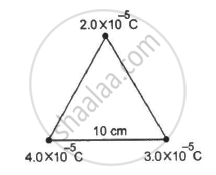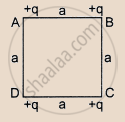Advertisements
Advertisements
प्रश्न
Find the ratio of the electrical and gravitational forces between two protons.
उत्तर
We know that the mass of a proton, m = 1.67 × 10−27 kg
Charge on a proton, q = 1.6 × 10−19 C
Gravitational constant,
\[G = 6 . 67 \times {10}^{- 11} N - \text{m}^2 / {\text{kg}}^2\]
Electrostatic force,
\[F_e = \frac{1}{4\pi \epsilon_0}\frac{q^2}{r^2}\]
Gravitational force,
\[F_g = G\frac{m^2}{r^2}\]
\[ \Rightarrow \frac{F_e}{F_g} = \frac{q^2}{4\pi \epsilon_0 \text{G m}^2}\]
\[ = \frac{9 \times {10}^9 \times \left( 1 . 6 \times {10}^{- 19} \right)^2}{6 . 67 \times {10}^{- 11} \times \left( 1 . 67 \times {10}^{- 27} \right)^2}\]
\[ = 1 . 23 \times {10}^{36}\]
APPEARS IN
संबंधित प्रश्न
Four point charges qA = 2 μC, qB = −5 μC, qC = 2 μC, and qD = −5 μC are located at the corners of a square ABCD of side 10 cm. What is the force on a charge of 1 μC placed at the centre of the square?
Write any two important points of similarities and differences each between Coulomb's law for the electrostatic field and Biot-Savart's law of the magnetic field ?
Find the dimensional formula of ε0.
Two equal charges are placed at a separation of 1.0 m. What should be the magnitude of the charges, so that the force between them equals the weight of a 50 kg person?
Find the electric force between two protons separated by a distance of 1 fermi (1 fermi = 10−15 m). The protons in a nucleus remain at a separation of this order.
Suppose the second charge in the previous problem is −1.0 × 10−6 C. Locate the position where a third charge will not experience a net force.
Estimate the number of electrons in 100 g of water. How much is the total negative charge on these electrons?
Find the speed of the electron in the ground state of a hydrogen atom. The description of ground state is given in the previous problem.
Two charged particles with charge 2.0 × 10−8 C each are joined by an insulating string of length 1 m and the system is kept on a smooth horizontal table. Find the tension in the string.
Two identical pith balls are charged by rubbing one against the other. They are suspended from a horizontal rod through two strings of length 20 cm each, the separation between the suspension points being 5 cm. In equilibrium, the separation between the balls is 3 cm. Find the mass of each ball and the tension in the strings. The charge on each ball has a magnitude 2.0 × 10−8 C.
Two small spheres, each with a mass of 20 g, are suspended from a common point by two insulating strings of length 40 cm each. The spheres are identically charged and the separation between the balls at equilibrium is found to be 4 cm. Find the charge on each sphere.
Two particles A and B, each carrying a charge Q, are held fixed with a separation dbetween them. A particle C of mass m and charge q is kept at the middle point of the line AB. Under what conditions will the particle C execute simple harmonic motion if it is released after such a small displacement? Find the time period of the oscillations if these conditions are satisfied.
How much work has to be done in assembling three charged particles at the vertices of an equilateral triangle, as shown in the figure?
The force between two charges 0.06 m apart is 5 N. If each charge is moved towards the other by 0.01 m, then the force between them will become ____________.
The electric force acting between two point charges kept at a certain distance in vacuum is 16 N. If the same two charges are kept at the same distance in a medium of dielectric constant 8, the electric force acting between them is ____________ N.
Four equal charges q are placed at the four comers A, B, C, D of a square of length a. The magnitude of the force on the charge at B will be ______.

There is another useful system of units, besides the SI/mks A system, called the cgs (centimeter-gram-second) system. In this system Coloumb’s law is given by
F = `(Qq)/r^2 hatr`
where the distance r is measured in cm (= 10–2 m), F in dynes (= 10–5 N) and the charges in electrostatic units (es units), where 1 es unit of charge = `1/([3]) xx 10^-9 C`
The number [3] actually arises from the speed of light in vaccum which is now taken to be exactly given by c = 2.99792458 × 108 m/s. An approximate value of c then is c = [3] × 108 m/s.
(i) Show that the coloumb law in cgs units yields
1 esu of charge = 1 (dyne)1/2 cm.
Obtain the dimensions of units of charge in terms of mass M, length L and time T. Show that it is given in terms of fractional powers of M and L.
(ii) Write 1 esu of charge = x C, where x is a dimensionless number. Show that this gives
`1/(4pi ∈_0) = 10^-9/x^2 (N*m^2)/C^2`
With `x = 1/([3]) xx 10^-9`, we have `1/(4pi ∈_0) = [3]^2 xx 10^9 (Nm^2)/C^2`
or, `1/(4pi ∈_0) = (2.99792458)^2 xx 10^9 (Nm^2)/C^2` (exactly).
According to Coulomb's law, which is the correct relation for the following figure?

